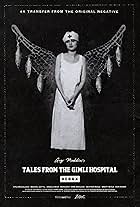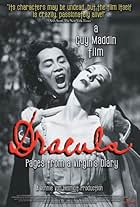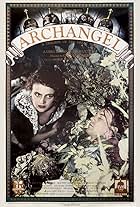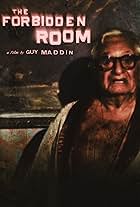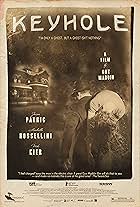Ajouter une intrigue dans votre langueThe wary residents of a 19th century mountain village must tread carefully and speak softly lest they cause an avalanche. Sexual frenzies teem in this world of repression, setting off incest... Tout lireThe wary residents of a 19th century mountain village must tread carefully and speak softly lest they cause an avalanche. Sexual frenzies teem in this world of repression, setting off incestuous love triangles with deadly consequences.The wary residents of a 19th century mountain village must tread carefully and speak softly lest they cause an avalanche. Sexual frenzies teem in this world of repression, setting off incestuous love triangles with deadly consequences.
- Prix
- 1 victoire au total
Andrea Von Wichert
- Townsperson
- (as Andrea Wichert)
Histoire
Le saviez-vous
- AnecdotesRebecca Gibson's debut.
- ConnexionsFeatured in Guy Maddin: Waiting for Twilight (1997)
Commentaire en vedette
The USA Film Festival described this as Twin Peaks directed by Erich von Stroheim. Not a bad description. It's an uproarious satire, in the vein of YOUNG FRANKENSTEIN ... but the film often so beautifully duplicates the material it parodies that your breath is taken away. It's a little like reading a hysterical comic book, and finding original paintings by old masters salted throughout!
This brilliant Canadian film heavily borrows from the high-camp expressionism of German silent films and early talkies, especially the "mountain" films of Leni Riefenstahl. Anyone who's read FROM CALIGARI TO HITLER will recognize dozens of scenes in this film as near carbons of stills from the book. Perhaps more than any other films before or since, German silent cinema created compelling images that tap into universal race consciousness, portraying grainy, moving archetypal images all of us vaguely recognize from dreams or nightmares. Because of this, CAREFUL will often take your breath away with unexpected moments of quiet majesty and beauty. But there are plenty of laughs in between, (with "sick," 70's style National Lampoon-like humor). If you've never laughed at seeing an eye poked out, leave political correctness at the door and give this film a whirl!
The soundtrack if often deliberately scratchy or muffled, and in several scenes easter-egg like colors are used that resemble the early two-strip technicolor process. Ominous title cards are used to introduce scenes. This bizarre film is salted with unexpected dialogue like this: BOY: "My, aren't you the frisky one today." GIRL: "Even the reindeer are such, when Spring is coming!"
Enough of the aesthetics, what is the film supposedly about? The action takes place in the 19th century alpine village of Tolzbad, that is so precariously poised under constant threat of avalanche that villagers have learned to communicate only in whispers. Animals have had their vocal chords removed, and gramophones have lambs wool stuffed in the horn. Villagers keep time to the "sound" of silent instruments at a "concert." There are handful of soundproof ice caves where the villagers can frolic and shout, letting out their pent up, pagan passions. The film is clearly a biblical parable about repression. Jackie Burroughs does a brilliant bit part as the puritanical teacher, who closely resembles the Cloris Leachman role in YOUNG FRANKENSTEIN.
All of the characters display a surface naivete; actresses speak in the perky, breathless voices reminiscent of badly dubbed post-war European B films; "strapping" young sons still wear short pants'd school uniforms. The film quickly descends below the surface to show the village as a cauldron of incestuous flirtations, violent retaliation and explosive "family secrets." The plot follows an arc of forbidden loves and passions, leading to retribution on a biblical scale. What may appear to the modern audience as "cheap" special effects are actually loving recreations of how ghosts and visions were portrayed in silent and early talking German films. Many of the images are unforgettable, like the "trolley" cars pulled by oxen, or the mine workers wearing crowns of flickering candles. Uncoated lenses and back lit hair make some closeups resemble images from early Garbo or Dietrich films.
CAREFUL warrants multiple viewings. Watch it with a friend; this is definitely a film you'll want to dissect over several capuccinos.
This brilliant Canadian film heavily borrows from the high-camp expressionism of German silent films and early talkies, especially the "mountain" films of Leni Riefenstahl. Anyone who's read FROM CALIGARI TO HITLER will recognize dozens of scenes in this film as near carbons of stills from the book. Perhaps more than any other films before or since, German silent cinema created compelling images that tap into universal race consciousness, portraying grainy, moving archetypal images all of us vaguely recognize from dreams or nightmares. Because of this, CAREFUL will often take your breath away with unexpected moments of quiet majesty and beauty. But there are plenty of laughs in between, (with "sick," 70's style National Lampoon-like humor). If you've never laughed at seeing an eye poked out, leave political correctness at the door and give this film a whirl!
The soundtrack if often deliberately scratchy or muffled, and in several scenes easter-egg like colors are used that resemble the early two-strip technicolor process. Ominous title cards are used to introduce scenes. This bizarre film is salted with unexpected dialogue like this: BOY: "My, aren't you the frisky one today." GIRL: "Even the reindeer are such, when Spring is coming!"
Enough of the aesthetics, what is the film supposedly about? The action takes place in the 19th century alpine village of Tolzbad, that is so precariously poised under constant threat of avalanche that villagers have learned to communicate only in whispers. Animals have had their vocal chords removed, and gramophones have lambs wool stuffed in the horn. Villagers keep time to the "sound" of silent instruments at a "concert." There are handful of soundproof ice caves where the villagers can frolic and shout, letting out their pent up, pagan passions. The film is clearly a biblical parable about repression. Jackie Burroughs does a brilliant bit part as the puritanical teacher, who closely resembles the Cloris Leachman role in YOUNG FRANKENSTEIN.
All of the characters display a surface naivete; actresses speak in the perky, breathless voices reminiscent of badly dubbed post-war European B films; "strapping" young sons still wear short pants'd school uniforms. The film quickly descends below the surface to show the village as a cauldron of incestuous flirtations, violent retaliation and explosive "family secrets." The plot follows an arc of forbidden loves and passions, leading to retribution on a biblical scale. What may appear to the modern audience as "cheap" special effects are actually loving recreations of how ghosts and visions were portrayed in silent and early talking German films. Many of the images are unforgettable, like the "trolley" cars pulled by oxen, or the mine workers wearing crowns of flickering candles. Uncoated lenses and back lit hair make some closeups resemble images from early Garbo or Dietrich films.
CAREFUL warrants multiple viewings. Watch it with a friend; this is definitely a film you'll want to dissect over several capuccinos.
- maxwellhoffmann
- 8 oct. 2003
- Lien permanent
Meilleurs choix
Connectez-vous pour évaluer et surveiller les recommandations personnalisées
- How long is Careful?Propulsé par Alexa
Détails
Contribuer à cette page
Suggérer une modification ou ajouter du contenu manquant














